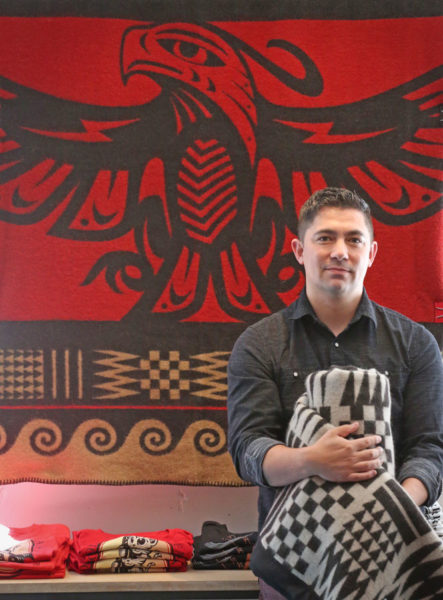
Louie Gong had spent eight years growing a successful online business selling his and others’ Native-designed art. Fans told him to open his own shop, but Gong said he was only going bricks-and-mortar on one condition: that he could open a store at the Pike Place Market.
In part, Gong wanted the best possible opportunity to sell his company’s products (reportedly the only ones sold by a Native-owned company in the U.S.), which range from wool blankets to Native-designed iPhone covers.
But profit isn’t his only motivation for setting up shop in such a high-profile location.
“We also want to control the narrative about contemporary Native people,” says Gong, the local artist and entrepreneur behind Eighth Generation. “We’re hardworking professionals who can do amazing things.”
Gong says there’s no better place to demonstrate that than in the symbolic heart of Seattle, in front of visitors from around the world. And last year, the opportunity arrived in the form of a light-filled space in the building above the gum wall.
“This is 1,300 square feet of stereotype busting,” says Gong about the new Eighth Generation flagship store, opening Saturday. He says it is the only Native-owned store at Pike Place Market, though Native art is often sold by non-Natives.
But Gong, who grew up in the Nooksack tribal community, didn’t always know he wanted to be an entrepreneur or an artist.
“If you look at the market for products featuring cultural art, it’s totally dominated by non-Native companies,”
Ten years ago he was working for the Muckleshoot Tribal College as an educational resources coordinator and helping them prepare to host the annual canoe journey. Gong, who took one art class in the eighth grade and “probably got a C,” was tasked with painting 30 drums as gifts for visiting participants.
The experience, alongside encouragement from tribal elders, “unlocked” a passion for cultural art, and within a year Gong was decorating and eventually selling shoes with custom designs that blended traditional Coast Salish art, Gong’s own heritage, and urban influences.
Those shoes helped launched the Eighth Generation website and ultimately the “Inspired Natives Project,” which works with other Native artists to manufacture and sell their work under the Eighth-Generation label.
“Inspired Natives” is a play on “Native Inspired,” a tag Gong says is often placed on goods looking to skirt laws meant to help consumers distinguish between actual Native-designed items and companies that co-opt Native designs and traditions.
“If you look at the market for products featuring cultural art, it’s totally dominated by non-Native companies,” says Gong, citing the Oregon-based company Pendleton, known for their iconic wool blankets, as an example of a business using the “Native Inspired” tag. “And most of those non-Native companies are just taking the art from the communities.”
“Inspired Native” not only helps Natives to bring their products to market, it also acknowledges and elevates work that defies expectations of what Native art is.
The art showcased at the new Eighth Generation store does just that. There’s a midcentury modern couch upholstered in wool featuring a Coast Salish weaving pattern, soap made with salt from the Salish Sea and phone cases featuring Gong’s own signature designs.
“A lot of the time, business owners selling cultural art will look to make consumers feel good about the stereotypes they already have,” says Gong. “That’s why Native people are often represented as symbols of ancient history or symbols of the natural environment, instead of contemporary, skilled, hardworking professionals.”
With that in mind, the Eighth Generation store also has a workspace and community room where people can see Native artists “kicking ass” on site.
“I look at art like any other natural resource,” says Gong, as he cheerfully fends off a stream of people knocking on the doors hoping to sneak a peek at the new store. “If people keep taking from it and taking from it, without nurturing the environment that created it in the first place, then eventually you kill it.”
But not on his watch.

